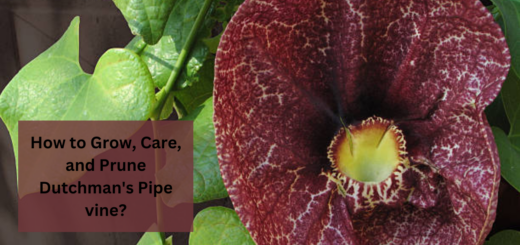How to grow Angel vine in a pot? – Care, Growth, and facts
Ever wondered how to grow an angel vine in a pot? Is it easy to grow? Wondering how to cultivate them? I’m here to help you.
Trust me, I’m not lying; it’s possible to grow angel vine in a pot by following basic requirements such as sunlight, soil, water, fertilizer, and temperature. Cultivating it in the perfect environment will make it bloom their best.
Here, I have explained all my implemented methods that will help your angel vine thrive happily. So let’s start learning and add them to our houseplant collection as soon as possible.
Key takeaways:
- Angle vines play an important role in the environment of their habitat naturally. Some other vines you can grow are Vinca Minor Vine, Sweet Potato vines, Dutchman’s Pipe Vine, etc.
- They can grab the man-made and human consequences while even suppressing the growth and nourishment of new weeds.
- Coastal copper butterflies, Aphis cotton aphids, pahoehoe gall moths, and pahoehoe pocket gall mites are among the many species that call them home.
- It is simple if you let them have partial to the full sun like other sun herbs Chives, Chervil, Mint, Lemon, etc. It is also known as Muehlenbeckia Complex.
- These are even native to some places in New Zealand, there you can see them growing in numerous habitats which include montane, lowland regions, and even more.
How to grow a potted Angel vine?
Angel vine is commonly cultivated as an annual in the garden, but it can also be planted in a container as a houseplant or outdoors. Angel vine in a container can be grown all year in frost-free regions. Plants can withstand temperatures ranging from 0 to 10 degrees Fahrenheit in zone 7. (-18 to -12 C). Keep in mind that thinner terra cotta or concrete pots may shatter outdoors during freeze/thaw cycles if you live in an area where you can grow this plant all year but it still gets cold. It is safer to use thicker pots and larger pots that contain more soil to avoid damage from freezing conditions.
| Common Name | Brugmansia, trumpet of death, Angel’s trumpet, Moonflower |
| Botanical Name | Brugmansia |
| Family | Solanaceae |
| Plant Type | Perennial, shrub |
| Mature Size | 6–35 ft. tall, 3–10 ft. wide |
| Sun Exposure | Full |
| Soil Type | Moist, but well-drained |
| Soil pH | Acidic |
| Bloom Time | Summer |
| Flower Color | White, yellow, orange, pink |
| Hardiness Zones | 9–11 (USDA) |
| Native Area | South America |
| Toxicity | Toxic to people, toxic to pets |
It is safer to use thicker pots and larger pots that contain more soil to avoid damage from freezing conditions. If you wish to keep the plant outside but live in a moderately hardy zone for this plant, the additional soil will assist insulate the plants and assure that they will survive.
For optimal results, give your angel vine lots of sun. When it comes to irrigation, these plants prefer moist, well-drained soil. Angel vine grows well in an excellent all-purpose potting soil mix. Allow 2 to 4 inches (5-10 cm) of the top of the pot to dry out before watering fully again, depending on the size of the pot.
Fertilize during the growing season for the best benefits. Many various types of fertilizers can be utilized, but using a good time-release fertilizer is the most straightforward technique. It is easy to incorporate into the soil and provides a consistent supply of nutrients throughout the growing season. Because of the wiry stems, this plant has a naturally unruly appearance, but you can cut it back at any time during the growing season for a more tame appearance or a smaller plant. This will cause the plant to develop more compactly.
How to take care of your Angel vines?
Do you know how you can take care of your angel vines? Growing Nagel vines is simple but you need to maintain that growth. Angel vines are hardy in zones 8a through 10a and are endemic to New Zealand. They are frost-sensitive, so plant them in a container and bring them inside in colder climes. Angel vine care in containers is very simple, and many gardeners prefer to cultivate the plant in containers.
For more such plant related-articles, you may also read, How to Grow and Care for Desert Bluebell Flowers?
The vine grows quickly, reaching 15 feet (4.5 meters) in length and producing a thick covering of small spherical leaves. All of these features work together to make the plant good at taking on the shape of wire forms, resulting in a lovely topiary impression. It can also be trained to weave with a metal screen or fence to create a lovely opaque border.
Repotting Angel Vines:
You need to repot the plant once every two years and for repotting make sure to repot the pot that is larger in size than the previous pot. You need to fill the pot with fresh potting mix. The pot needs to have enough amount of drainage holes at the bottom so that excess water gets drained away from the holes. The plants are used to grow beautifully if you provide the plant with proper growing conditions and prune them at the right time. Cutting the unhealthy leaves and stems of the plants for new growth of the plant is encouraged. To maintain the compact shape of the plant you can prune them about one-third during spring. Make sure to provide them with proper space so that they get space to spread. You need to protect the plant from various insects such as aphids so when you see any signs of infestation you need to treat the plant by squishing, rinsing, or wiping the plant using a cotton pad that is dipped in rubbing alcohol. Using insecticides and pesticides will also help in keeping the pests away from the plants.
Propagating Angel Vine:
Using the stem for propagating the plant is the best, fastest, and easiest option you can choose. You can use them for making gifts for your loved ones. You need to select the stem that is healthy and has few leaves on the stem. The first is to cut the tip of the stem at about 3 to 4 inches. Make sure to dip the cutting in the rooting hormone before you transplant the cutting into the soil. You need to fill the pot with potting mix or perlite so that they thrive best. If taken care of properly you will observe the root system growing over a few times.
Few facts about Angel vines:
- Angel vines are frequently used for ornamental purposes, to produce exquisite topiaries, and to beautify trellises, thanks to their vining tendency.
- Birds such as the kereru, tui, and bellbird feed on their buds and leaves. They’re also a wonderful treat for possums, who can devour them entirely in no time.
- They’re extremely popular on both the East and West coasts of the United States, and they’ve also been successfully imported to Japan, Malaysia, Western Australia, and the United Kingdom.
- Because of its juicy texture and sweet taste, Mori people, particularly youngsters, used to eat their succulent blossoms.
- Angel vines thrive in full sun in the mornings and light shade in the afternoons. Place these plants in a setting that will allow them to flourish to their full potential.
Conclusion
In this article, you come to know about the angel vines. Now, you will be clear about the process of growing them. But only growing them is not sufficient, you have to take care of them.
FAQ’s
What kind of fertilizer do you need for angel vines?
you need to add an organic fertilizer or compost every 1 or 2 months so that the plant grows quickly and beautifully.
Which potting soil is considered the best for growing angel vines in a pot?
the potting soil that has little extra peat present in the soil is perfect for growing angle vines in a pot.
Growing angel vine is a hard task?
The angel vine is able to grow best in average household conditions.


